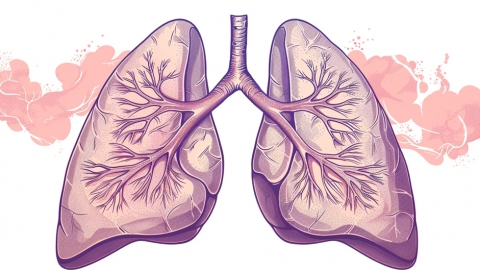What causes small nodules in the lungs?
Generally, pulmonary small nodules may be caused by environmental factors, unhealthy lifestyle habits, idiopathic pulmonary fibrosis, granulomatous vasculitis, pulmonary hypertension, and other factors. Symptomatic management usually involves general treatment, medication, and other approaches. If physical discomfort occurs, prompt medical consultation and treatment are recommended. Detailed analysis is as follows:

1. Environmental Factors
Long-term exposure to polluted environments, such as harmful airborne dust particles, toxic gases, and heavily polluted air, may damage lung tissue and subsequently lead to the formation of pulmonary small nodules. This may be accompanied by respiratory symptoms such as coughing, sputum production, and difficulty breathing. It is recommended to improve unhealthy living environments, such as wearing masks to reduce inhalation of harmful substances and enhancing indoor air purification.
2. Unhealthy Lifestyle Habits
Long-term smoking and heavy油烟 (cooking oil fumes) generated during cooking are unhealthy habits that may trigger inflammatory responses in the lungs, leading to the formation of pulmonary small nodules. Symptoms such as coughing, sputum production, and chest tightness may occur. It is recommended to quit smoking, improve cooking environments, and enhance lung protection to help prevent the occurrence of this condition.
3. Idiopathic Pulmonary Fibrosis
Idiopathic pulmonary fibrosis is a chronic inflammatory lung disease that leads to gradual replacement of lung tissue by scar tissue. Small nodules may sometimes be observed on imaging studies, accompanied by symptoms such as dry cough and difficulty breathing. It is recommended to follow medical advice to use medications such as pirfenidone capsules, nintedanib soft capsules, and prednisone acetate tablets to alleviate symptoms.
4. Granulomatous Vasculitis
Granulomatous vasculitis is a rare autoimmune disease that affects multiple organs, especially the lungs and kidneys. It can cause pulmonary hemorrhage and formation of small nodules, potentially presenting with symptoms such as fever, weight loss, and joint pain. It is recommended to follow medical guidance for treatment with medications such as methylprednisolone tablets, cyclosporine soft capsules, and tacrolimus capsules.
5. Pulmonary Hypertension
Pulmonary hypertension refers to abnormally elevated blood pressure in the pulmonary arteries. Long-term progression can lead to right ventricular hypertrophy and lesions in small pulmonary arteries. Small nodule-like appearances may sometimes be observed on imaging studies, accompanied by symptoms such as dyspnea, fatigue, and syncope. It is recommended to follow medical guidance for treatment with medications such as warfarin sodium tablets, aspirin tablets, and digoxin tablets.
In daily life, it is recommended to maintain good lifestyle habits, such as moderate exercise and a balanced diet, which can help promote overall health.
References
[1] Ji Huirong, Cao Yupeng, Shi Guangyong. The clinical diagnostic value of CT in pulmonary small nodules [J]. Imaging Research and Medical Applications, 2024, 8(08): 102-104.
[2] Yang Fuzhi, Yao Yuanshan, Chen Chunjī, et al. Research progress on localization of pulmonary small nodules under thoracoscopy [J]. Geriatrics & Health Care, 2023, 29(01): 152-155.





